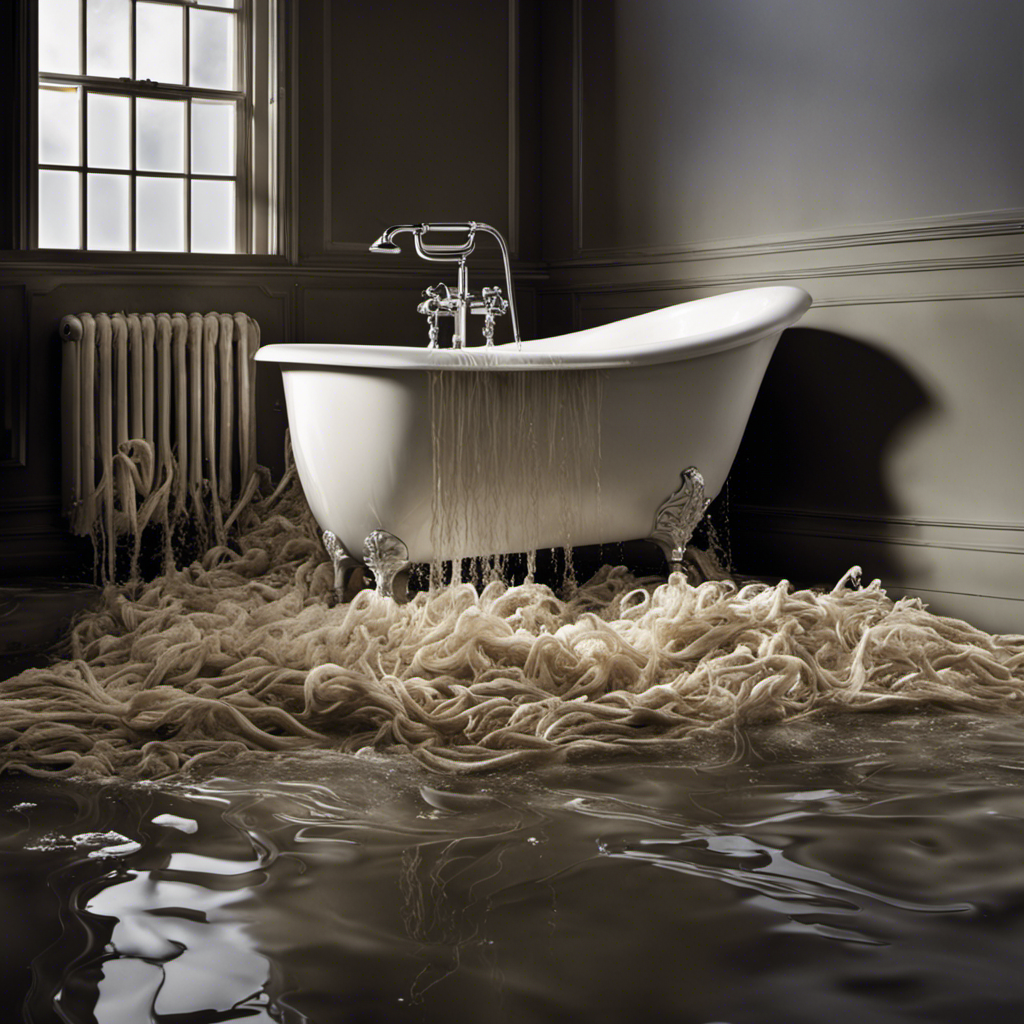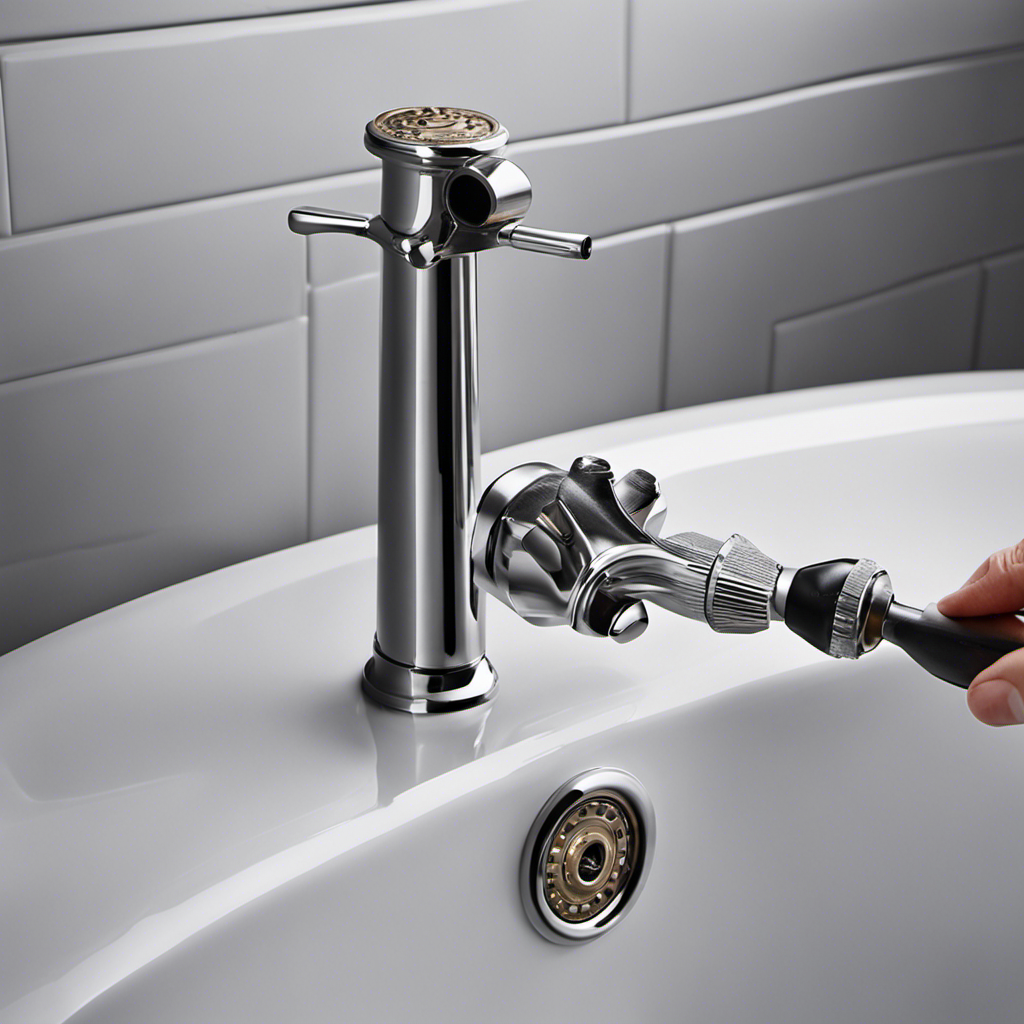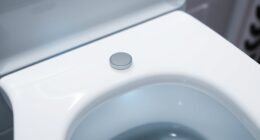Have you ever experienced the frustrating situation of standing ankle-deep in water while taking a shower? Well, you’re not alone. Bathtub drain clogs can be a pesky problem that disrupts our daily routines.
In this article, I will delve into the common causes of bathtub drain clogs, provide DIY methods to clear them, discuss signs of a blocked drain, explore professional solutions for stubborn clogs, and offer tips for preventing future issues.
Get ready to bid farewell to those slow-draining tubs!
Key Takeaways
- Hair and soap buildup in the drain and accumulation of sticky substances on pipe walls are common causes of bathtub drain clogs.
- DIY methods to clear a clogged bathtub drain include using a plunger, pouring hot water down the drain, using a drain snake, and using a baking soda and vinegar mixture.
- Signs of a blocked bathtub drain include water pooling around feet, slow drainage, gurgling sounds, and frequent backups or overflows.
- Professional solutions for stubborn bathtub drain clogs include hydro jetting, drain snaking, video inspection, chemical drain cleaners, and pipe replacement in severe cases.
Common Causes of Bathtub Drain Clogs
One common cause of bathtub drain clogs is that you’ve been washing a lot of hair down the drain. Hair and soap buildup can easily accumulate in your drain over time, leading to a clog that prevents water from flowing freely.
When hair combines with soap scum, it forms a sticky substance that clings to the walls of your pipes. This buildup can be difficult to remove without proper intervention. Chemical drain cleaners are often used to dissolve this stubborn residue and clear the clog.
These cleaners contain strong chemicals that break down the hair and soap buildup, allowing water to flow smoothly again. However, it’s important to use these cleaners with caution, as they can be harmful to both your pipes and your health if not used correctly.
DIY Methods to Clear a Clogged Bathtub Drain
To clear a clogged bathtub drain, you can try using a plunger or pouring hot water down the drain. These methods are often effective in dislodging small blockages and restoring the flow of water.
Here are some additional DIY methods you can try:
-
Using a drain snake: This tool helps to remove debris that is causing the clog by physically breaking it up and pulling it out.
-
Baking soda and vinegar: Mixing these two ingredients and pouring the mixture down the drain can create a chemical reaction that helps to dissolve the clog.
-
Removing the overflow plate: Sometimes the clog is located in the overflow pipe. By removing the overflow plate and cleaning out any debris, you may be able to clear the clog.
-
Boiling water and salt: Dissolving salt in boiling water and pouring it down the drain can help to break down grease and other substances causing the clog.
-
DIY drain cleaner: Mixing baking soda, salt, and cream of tartar and pouring it down the drain followed by boiling water can help to dissolve tough clogs.
Remember to proceed with caution and avoid using chemical drain cleaners as they can be harmful to the pipes and your health.
Signs of a Blocked Bathtub Drain
If you notice water pooling around your feet during a shower, it’s likely a sign that your bathtub drain is blocked. Slow drainage is usually caused by a partial clog in the drain pipe.
There are several signs that can indicate a blocked bathtub drain. Firstly, you may notice that water takes longer than usual to drain after you finish showering or bathing. Additionally, you may hear gurgling sounds coming from the drain when water is draining. Another sign is if you frequently experience backups or overflows when using the bathtub.
These signs suggest that there is a buildup of hair, soap scum, or other debris in the drain pipe, restricting the flow of water. It’s important to address these issues promptly to avoid complete blockage and potential water damage.
Professional Solutions for Stubborn Bathtub Drain Clogs
There are several professional solutions available for stubborn bathtub drain clogs. When it comes to hiring professionals, you can trust that they have the expertise and specialized tools to effectively tackle even the toughest clogs.
Here are some effective drain cleaning methods that professionals use:
- Hydro jetting: This method uses high-pressure water to blast away debris and buildup in the drain pipes.
- Drain snaking: A flexible metal cable with a corkscrew-like tip is inserted into the drain to break up and remove clogs.
- Video inspection: Professionals use cameras to visually inspect the inside of the drain pipes, helping them identify the exact cause and location of the clog.
- Chemical drain cleaners: These powerful chemicals can dissolve clogs, but they should be used with caution and only by professionals.
- Pipe replacement: In severe cases, professionals may recommend replacing the damaged or corroded pipes to resolve the issue.
Preventing Future Bathtub Drain Issues
You can prevent future issues with your bathtub drain by regularly cleaning and maintaining it. Proper maintenance for bathtub drains is crucial to avoid clogs and keep the water flowing smoothly.
One eco-friendly option for preventing bathtub drain clogs is using a combination of baking soda, vinegar, and hot water. Start by pouring half a cup of baking soda down the drain, followed by half a cup of vinegar. Let it sit for a few minutes and then flush it with hot water. This natural solution helps break down any residue or build-up in the pipes.
Another eco-friendly option is using a drain strainer to catch hair and debris before it enters the drain. Regularly cleaning the strainer will prevent clogs and keep your drain in good condition.
Frequently Asked Questions
How Do I Remove a Bathtub Drain Stopper?
To remove a bathtub drain stopper, you can use a flathead screwdriver or pliers to unscrew it counterclockwise. Different types of bathtub drain stoppers may require slightly different methods, so be sure to consult the manufacturer’s instructions.
Can I Use Baking Soda and Vinegar to Unclog My Bathtub Drain?
I can unclog my bathtub drain by using baking soda and vinegar. Bleach can also be effective. If those don’t work, I can try a plunger to remove any blockage.
What Are Some Signs That My Bathtub Drain Is Clogged With Hair?
To prevent hair clogs in your bathtub drain, look out for signs like slow draining and standing water. Regularly clean the drain with a hair catcher and use a plumber’s snake if needed.
Do I Need to Hire a Professional Plumber to Clear a Stubborn Bathtub Drain Clog?
If my bathtub drain is stubbornly clogged, I can try DIY methods like using a plunger or drain snake. However, hiring a professional plumber has its pros, such as expertise and specialized tools.
How Often Should I Clean and Maintain My Bathtub Drain to Prevent Future Clogs?
To prevent bathtub drain clogs, it’s important to regularly clean and maintain the drain. Here are some tips: use a drain cover, avoid pouring grease down the drain, and periodically flush the drain with hot water.
Conclusion
In conclusion, dealing with a bathtub drain clog can be a frustrating experience. However, with the right knowledge and tools, it is possible to clear the clog and prevent future issues.
Remember, 85% of bathtub drain clogs are caused by hair and soap scum buildup. This statistic highlights the importance of regular maintenance and proper cleaning to keep your bathtub drain flowing smoothly.
By taking proactive measures, you can avoid the hassle of a clogged bathtub drain and enjoy a relaxing bath every time.










